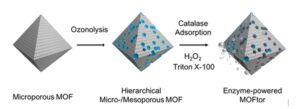This work was co-led by researchers from the Institute for Bioengineering of Catalonia (IBEC) and scientists from the Catalan Institute of Nanoscience and Nanotechnology (ICN2).

Image: Enzyme-Powered Porous Micromotors Built from a Hierarchical Micro- and Mesoporous UiO-Type Metal–Organic Framework. (2020) Journal of the American Chemical Society.
Micromotors are miniature vehicles that are expected to revolutionise the fields of biomedicine and environmental quality control and remediation. A range of promising applications are currently being explored for these tiny devices, which are characterised by their ability to self-propel. From targeted drug delivery to microsurgery and more, micromotors have even the potential to be used to clean up contaminants from the environment. Over the past decade, scientists around the world have been investigating different bioinspired designs and biocompatible materials for safe and efficient micromotors.
In a paper recently published in the Journal of the American Chemical Society, researchers describe how they built enzyme-powered micromotors from tiny metal-organic framework crystals. Their cutting-edge devices have pores of different sizes that allow them to encapsulate enzyme “engines” in the mesopores, as well as other smaller target substances in the micropores, such as environmental contaminants. This work was co-led by Dr. Tania Patiño (Institute for Bioengineering of Catalonia and University of Rome) and Dr Vincent Guillerm (Catalan Institute of Nanoscience and Nanotechnology, ICN2 and KAUST) within the framework of a BIST Ignite Project. It was conducted in collaboration with Dr. Samuel Sánchez, ICREA Research Professor and Leader of the Smart Nano-Bio-Devices Group at the IBEC, researchers Xavier Arqué (co-first author) and Pascal-Raphael Blersch from IBEC, ICREA Research Prof. Daniel Maspoch, leader of the ICN2 Supramolecular NanoChemistry and Materials group, as well as Yunhui Yang (co-first author), Dr. Javier Pérez-Carvajal and Dr. Inhar Imaz from the ICN2.
“Our joint efforts to merge fundamental and advanced knowledge in both porous materials design and self-propelled micromotors have enabled a significant step forward towards applications”, states Dr. Vincent Guillerm.
“These new micromotors from metal-organic framework crystals can be loaded with enzymes that act as engines, but they also have free cargo space that could be used to deliver drugs or to remove contaminants from the environment”, explains Dr. Tania Patiño.
Enzyme-powered micromotors based on metal-organic frameworks (MOFs)
To build these new micromotors, IBEC and ICN2’s researchers used a type of tiny porous crystal structures known as metal-organic frameworks (MOFs). The fact that these MOFs have micropores makes them particularly attractive as micromotor chassis, since the pores can act as cargo space. However, any functional vehicle also needs space for the engine. In this case, a process known as ozonolysis was used to create bigger cavities in the crystals: mesopores wide enough for enzyme “engines” to fit inside.
These new micromotors, dubbed “MOFtors” by the authors of this work, are powered by an enzyme called catalase. Its role in organisms is to convert hydrogen peroxide into water and oxygen gas. Therefore, when hydrogen peroxide “fuel” was added to the MOFtors, the oxygen bubbles created by the reaction were expelled from the pores, generating jet-like propulsion. In addition, these prototypes exhibited high fuel efficiency. In other words, they only needed a small amount of hydrogen peroxide to self-propel, which offers the added benefit of minimising the concentration of this toxic substance in biological and environmental applications.
MOFtors can be used for adsorbing additional species
Since these particles have pores of different sizes, they have additional free cargo space. The researchers tested their ability to soak up a contaminant from water, like tiny vacuum cleaners. The contaminant used, a dye known as rhodamine B, is a common water pollutant from the textile, plastic, and dye industries. When the MOFtors were added to contaminated water without hydrogen peroxide fuel, their pores mopped up around 14.6% of the dye. However, when hydrogen peroxide was added, the “switched on” engines soaked up more than 50% of the contaminant as they self-propelled through the water.
This work emphasizes the high potential of MOF crystals as micromotors. As the authors point out, crystal shape and pore size can be tuned to unlock a multitude of potential applications for these next-generation devices.
Reference article: Yunhui Yang, Xavier Arqué, Tania Patiño, Vincent Guillerm, Pascal-Raphael Blersch, Javier Pérez-Carvajal, Inhar Imaz, Daniel Maspoch, and Samuel Sánchez. “Enzyme-Powered Porous Micromotors Built from a Hierarchical Micro- and Mesoporous UiO-Type Metal–Organic Framework” (2020) Journal of the American Chemical Society.





